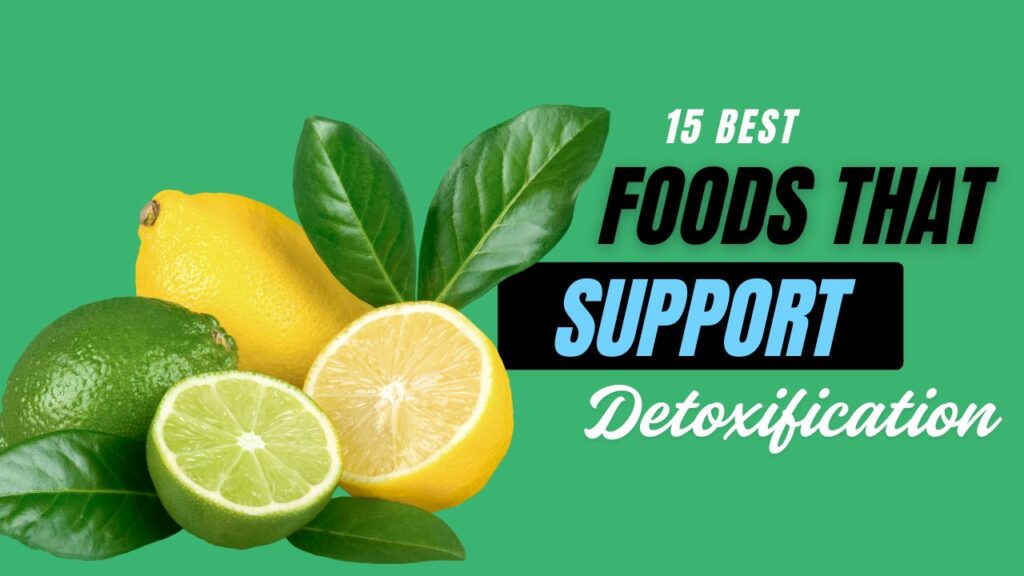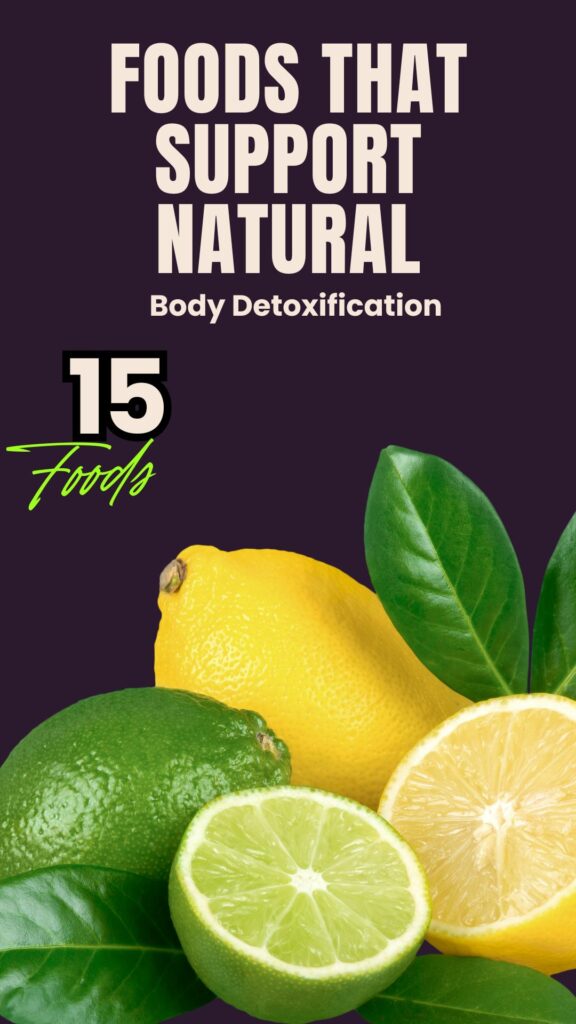Some links in this post are affiliate links. If you make a purchase through these links, I may receive a small commission. This helps support the site at no extra cost to you.
Do you know that your body already has a powerful detox system built in? Your liver, kidneys, lungs, skin, and digestive tract all work around the clock to filter toxins, process waste, and keep you energized.
But here’s the catch—modern lifestyles, processed foods, pollution, and stress often overload these systems, leaving us sluggish, bloated, and low on vitality.
The good news? Certain foods can give your body’s natural detox pathways a powerful boost. They’re not “miracle cleanses” or quick fixes (those are mostly myths), but everyday ingredients that help your liver work more efficiently, support digestion, reduce inflammation, and flush out toxins naturally.
In this post, we’ll explore 15 scientifically recognized foods that support your body’s detoxification process. You’ll discover:
- How each food contributes to cleansing and detoxing naturally
- The best ways to eat or use them
- Who should enjoy them (and who might need to limit)
- Storage and buying tips for freshness
- Do’s & Don’ts for maximum benefit
- Possible side effects (if any)
Let’s dive into the foods that your body will thank you for!

Table of Contents

15 Best Foods For Natural Detoxification
1. Leafy Greens (Spinach, Kale, Swiss Chard)
Leafy greens are nutritional powerhouses, loaded with chlorophyll that binds to toxins and helps flush them out of your bloodstream. They’re also rich in fiber, which keeps your digestive system moving smoothly.
Best Ways to Eat or Use It
- Add to smoothies for a morning detox boost
- Steam lightly to preserve antioxidants
- Use as a base for salads or stir-fries
Who Should Eat / Avoid
- Good for: Weight-loss seekers, people with sluggish digestion, and athletes needing mineral-rich foods
- Avoid if: You have kidney stones or are advised to limit oxalates
Storage & Buying Tips
- Look for vibrant green leaves without yellow spots
- Store unwashed in the fridge wrapped in a paper towel
- Use within 3–5 days for best freshness
Do’s & Don’ts
✅ Do: Rotate different greens to avoid oxalate overload
❌ Don’t: Overcook, as it destroys vitamin C
Possible Side Effects
- High intake may interfere with calcium absorption in some people
2. Lemon
Lemons are widely associated with detox, and for good reason. Their vitamin C content boosts liver enzyme activity and helps convert toxins into water-soluble forms for easier elimination.
Best Ways to Eat or Use It
- Squeeze fresh lemon into warm water each morning
- Use in dressings or marinades
- Add slices to herbal teas
Who Should Eat / Avoid
- Good for: People struggling with indigestion, skin dullness, or low hydration
- Avoid if: You suffer from acid reflux or sensitive teeth
Storage & Buying Tips
- Choose heavy lemons with smooth skin
- Store in the fridge to keep fresh for 2–3 weeks
Do’s & Don’ts
✅ Do: Drink lemon water before meals for digestive support
❌ Don’t: Rely on lemon detox diets as a “quick cleanse”
Possible Side Effects
- Excessive lemon juice may erode tooth enamel
3. Garlic
Garlic is nature’s antibiotic, thanks to its sulfur compounds that support liver detoxification enzymes and fight harmful bacteria.
Best Ways to Eat or Use It
- Use raw in dressings or dips
- Add minced garlic to stir-fries or soups
- Roast whole cloves for a sweeter flavor
Who Should Eat / Avoid
- Good for: Immune support, reducing inflammation, and heart health
- Avoid if: You have bleeding disorders or take blood-thinning medications
Storage & Buying Tips
- Buy firm bulbs with tight skins
- Store in a cool, dry, and dark place
Do’s & Don’ts
✅ Do: Crush garlic and let it sit for 10 minutes to activate allicin
❌ Don’t: Microwave garlic—it destroys active compounds
Possible Side Effects
- Can cause digestive discomfort if eaten in large amounts
4. Beets
Beets are rich in betalains, compounds that support liver function and help break down toxins. They also improve blood flow and oxygenation.
Best Ways to Eat or Use It
- Blend into smoothies
- Roast with olive oil and herbs
- Add to salads for color and nutrition
Who Should Eat / Avoid
- Good for: Athletes, people with high blood pressure
- Avoid if: You’re prone to kidney stones (due to oxalates)
Storage & Buying Tips
- Choose firm beets with fresh greens attached
- Store unwashed in the fridge for up to 10 days
Do’s & Don’ts
✅ Do: Use beet greens—they’re just as nutritious
❌ Don’t: Overboil; it reduces antioxidant content
Possible Side Effects
- May cause red urine or stools (harmless)
5. Ginger
Ginger stimulates digestion, reduces nausea, and enhances circulation, helping the body move toxins efficiently.
Best Ways to Eat or Use It
- Brew ginger tea
- Grate into soups and stir-fries
- Blend fresh ginger into smoothies
Who Should Eat / Avoid
- Good for: Digestive health, reducing inflammation
- Avoid if: You’re on blood-thinning medications or pregnant (large amounts)
Storage & Buying Tips
- Choose firm, wrinkle-free roots
- Store in the fridge wrapped in paper towel
Do’s & Don’ts
✅ Do: Use fresh ginger for maximum potency
❌ Don’t: Overconsume—it may cause stomach upset
Possible Side Effects
- Can trigger heartburn in sensitive individuals
6. Green Tea
Green tea is rich in catechins, antioxidants that support liver detox and fat metabolism.
Best Ways to Eat or Use It
- Brew fresh hot or iced green tea
- Use matcha powder in smoothies
- Pair with lemon for enhanced absorption
Who Should Eat / Avoid
- Good for: Weight-loss seekers, people with high cholesterol
- Avoid if: Sensitive to caffeine or iron deficiency (can inhibit absorption)
Storage & Buying Tips
- Buy loose leaf for better quality
- Store in airtight containers away from sunlight
Do’s & Don’ts
✅ Do: Brew at lower temperatures (70–80°C) to avoid bitterness
❌ Don’t: Drink on an empty stomach if you’re sensitive
Possible Side Effects
- Too much caffeine can cause jitters and insomnia
7. Turmeric
Turmeric contains curcumin, which boosts liver detox enzymes and reduces inflammation.
Best Ways to Eat or Use It
- Add to curries, soups, or golden milk
- Pair with black pepper to enhance absorption
Who Should Eat / Avoid
- Good for: Joint pain, liver support
- Avoid if: You have gallstones or take blood-thinning drugs
Storage & Buying Tips
- Buy fresh root for maximum potency
- Store powdered turmeric in an airtight jar
Do’s & Don’ts
✅ Do: Combine with healthy fats for better absorption
❌ Don’t: Consume excessive supplements without guidance
Possible Side Effects
- High doses may upset the stomach
8. Apples
Rich in pectin, apples help bind heavy metals and cholesterol in the gut, aiding elimination.
Best Ways to Eat or Use It
- Eat raw as snacks
- Blend into smoothies or oatmeal
- Bake with cinnamon for a warm treat
Who Should Eat / Avoid
- Good for: Heart health, digestion, kids’ snacks
- Avoid if: Allergic to apples or on low-FODMAP diets
Storage & Buying Tips
- Pick firm apples without bruises
- Store in the fridge to keep crisp longer
Do’s & Don’ts
✅ Do: Eat with the skin for more fiber
❌ Don’t: Discard apple peels unnecessarily
Possible Side Effects
- Too many apples may cause bloating
9. Broccoli
Cruciferous veggies like broccoli contain sulforaphane, which enhances detox enzymes in the liver.
Best Ways to Eat or Use It
- Steam lightly
- Roast with garlic and olive oil
- Add raw florets to salads
Who Should Eat / Avoid
- Good for: Hormone balance, cancer prevention
- Avoid if: Thyroid issues (in very high amounts)
Storage & Buying Tips
- Choose firm, dark green florets
- Store unwashed in the fridge for up to a week
Do’s & Don’ts
✅ Do: Pair with mustard seeds to boost sulforaphane
❌ Don’t: Overboil—it destroys active compounds
Possible Side Effects
- Can cause gas or bloating
10. Avocado
Avocados provide glutathione, which supports liver detoxification, and healthy fats for nutrient absorption.
Best Ways to Eat or Use It
- Mash on whole-grain toast
- Blend into smoothies
- Add slices to salads and wraps
Who Should Eat / Avoid
- Good for: Heart health, skin glow, weight management
- Avoid if: You’re allergic to latex (cross-reaction)
Storage & Buying Tips
- Buy slightly firm avocados
- Ripen at room temperature, then refrigerate
Do’s & Don’ts
✅ Do: Add lemon juice to prevent browning
❌ Don’t: Leave cut avocado exposed to air for long
Possible Side Effects
- High calorie density—watch portions if on a strict calorie diet
11. Carrots
Carrots are high in beta-carotene and fiber, supporting liver and gut health.
Best Ways to Eat or Use It
- Eat raw as snacks
- Blend into juices
- Roast for a sweeter taste
Who Should Eat / Avoid
- Good for: Eye health, kids’ snacks
- Avoid if: You’re prone to caroteneemia (harmless orange skin tint)
Storage & Buying Tips
- Choose firm carrots without cracks
- Store in a cool fridge drawer
Do’s & Don’ts
✅ Do: Eat with healthy fats for better absorption
❌ Don’t: Peel unnecessarily—skin holds nutrients
Possible Side Effects
- Overeating may turn skin slightly orange
12. Blueberries
Packed with antioxidants, blueberries protect against oxidative stress and support detox pathways.
Best Ways to Eat or Use It
- Eat fresh or frozen
- Add to oatmeal, yogurt, or smoothies
Who Should Eat / Avoid
- Good for: Brain health, skin radiance
- Avoid if: Allergic to berries
Storage & Buying Tips
- Buy firm, deep blue berries
- Store unwashed in fridge; wash before eating
Do’s & Don’ts
✅ Do: Freeze extra berries to extend use
❌ Don’t: Wash before storing—it speeds spoilage
Possible Side Effects
- Rare allergies in sensitive individuals
13. Cabbage
Cabbage contains compounds that support liver detox enzymes and aid digestion.
Best Ways to Eat or Use It
- Ferment into sauerkraut
- Steam lightly
- Add to soups and stir-fries
Who Should Eat / Avoid
- Good for: Gut health, immunity
- Avoid if: Thyroid conditions (excess raw cabbage)
Storage & Buying Tips
- Choose firm, compact heads
- Store in the fridge wrapped in plastic
Do’s & Don’ts
✅ Do: Try fermented cabbage for probiotics
❌ Don’t: Overboil—it releases sulfur smell
Possible Side Effects
- May cause gas and bloating
14. Walnuts
Walnuts provide omega-3s and amino acids that support liver detoxification.
Best Ways to Eat or Use It
- Eat as snacks
- Add to oatmeal, salads, or smoothies
Who Should Eat / Avoid
- Good for: Brain health, athletes, vegetarians
- Avoid if: Nut allergy
Storage & Buying Tips
- Choose unsalted, raw walnuts
- Store in airtight containers in the fridge
Do’s & Don’ts
✅ Do: Soak before eating for easier digestion
❌ Don’t: Buy pre-ground—turns rancid quickly
Possible Side Effects
- High intake may cause digestive upset
15. Watermelon
Watermelon hydrates and flushes out toxins while providing antioxidants like lycopene.
Best Ways to Eat or Use It
- Eat chilled as snacks
- Blend into juices
- Add cubes to fruit salads
Who Should Eat / Avoid
- Good for: Hydration, athletes, hot climates
- Avoid if: Diabetes (moderate portions)
Storage & Buying Tips
- Pick heavy melons with hollow sound when tapped
- Store whole at room temperature, cut in fridge
Do’s & Don’ts
✅ Do: Eat fresh for hydration boost
❌ Don’t: Store cut watermelon for more than 2–3 days
Possible Side Effects
- Excess can cause bloating
Conclusion
Detox doesn’t have to mean restrictive juice cleanses or expensive supplements. By adding nutrient-dense, naturally detoxifying foods like leafy greens, lemons, garlic, and berries into your daily meals, you support your liver, kidneys, and digestive system in doing what they do best—keeping your body clean, energized, and balanced.
Try incorporating one or two of these foods into your meals this week. Even small changes, like swapping sugary snacks for fresh fruit or adding lemon water in the morning, can make a noticeable difference in your energy and overall well-being.
What about you? Which of these foods do you already love, and which one are you excited to try next? Share your favorite detox-friendly recipe in the comments!
Frequently Asked Questions (FAQs)
What is the best food for natural detoxification?
There isn’t one “best” food—your body benefits from a variety. Leafy greens, lemons, garlic, and green tea are among the top choices because they support liver function, digestion, and antioxidant defense.
Do I need to do a detox diet or juice cleanse?
No. Your liver, kidneys, lungs, and skin naturally detoxify your body. Eating whole, nutrient-dense foods enhances this process without extreme diets or cleanses.
Can I eat these detox foods every day?
Yes, most of these foods can be eaten daily in moderate amounts. Variety is key to avoid overconsumption of certain compounds (like oxalates in spinach or caffeine in green tea).
Who should avoid detox foods?
People with specific health conditions (like kidney stones, thyroid issues, or nut allergies) should be cautious. Always check with a doctor if you have a medical condition or are on medications.
Do detox foods help with weight loss?
They can support weight loss indirectly by improving digestion, reducing bloating, and replacing processed snacks. However, they are not “fat-burning miracles.” A balanced diet and activity remain essential.
How long does it take to notice results from detox foods?
Some benefits, like better digestion and hydration, can be felt within days. Others, such as improved skin clarity or energy, may take weeks of consistent healthy eating.
Can drinking lemon water alone detox my body?
No single food or drink can detox you on its own. Lemon water helps with hydration and digestion but works best as part of a healthy lifestyle.
Are detox foods safe during pregnancy?
Most are safe, but some (like too much ginger, turmeric, or unpasteurized juices) may need moderation. Pregnant women should consult their doctor before making big dietary changes.
Do detox foods interact with medications?
Yes, some might. For example, grapefruit can affect certain medications, and garlic or turmeric may thin the blood. Always check with a healthcare provider.
Is it better to eat detox foods raw or cooked?
Both have benefits. Raw foods preserve vitamin C and enzymes, while cooking enhances other compounds (like lycopene in tomatoes or beta-carotene in carrots). A mix of both is best.










